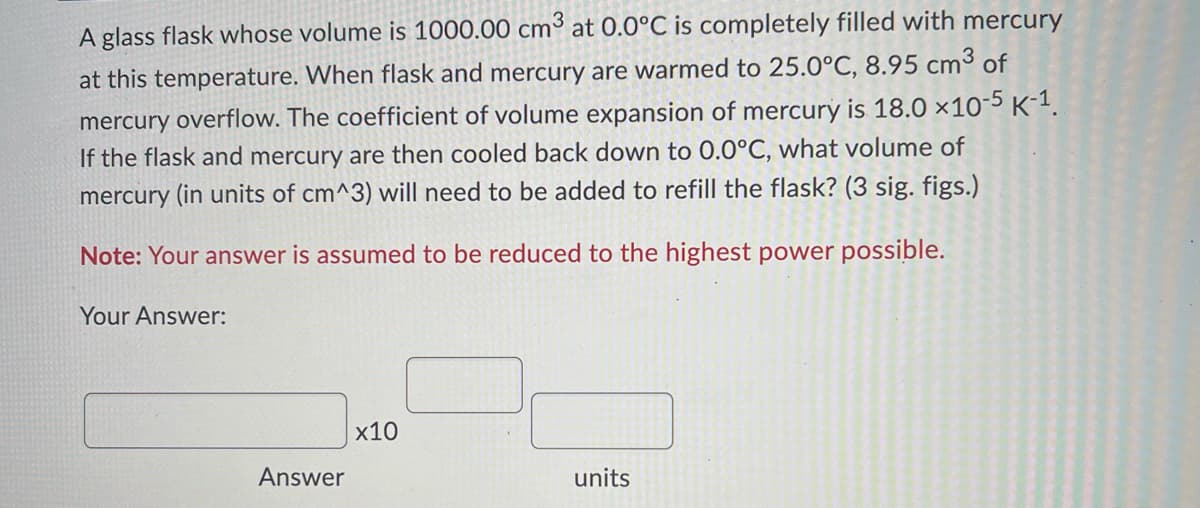A glass flask whose volume is 1000.00 cm³ at 0.0°C is completely filled with mercury at this temperature. When flask and mercury are warmed to 25.0°C, 8.95 cm³ of mercury overflow. The coefficient of volume expansion of mercury is 18.0 x10-5 K-1. If the flask and mercury are then cooled back down to 0.0°C, what volume of mercury (in units of cm^3) will need to be added to refill the flask? (3 sig. figs.)
A glass flask whose volume is 1000.00 cm³ at 0.0°C is completely filled with mercury at this temperature. When flask and mercury are warmed to 25.0°C, 8.95 cm³ of mercury overflow. The coefficient of volume expansion of mercury is 18.0 x10-5 K-1. If the flask and mercury are then cooled back down to 0.0°C, what volume of mercury (in units of cm^3) will need to be added to refill the flask? (3 sig. figs.)
Refrigeration and Air Conditioning Technology (MindTap Course List)
8th Edition
ISBN:9781305578296
Author:John Tomczyk, Eugene Silberstein, Bill Whitman, Bill Johnson
Publisher:John Tomczyk, Eugene Silberstein, Bill Whitman, Bill Johnson
Chapter2: Matter And Energy
Section: Chapter Questions
Problem 17RQ: At a constant pressure, how does a volume of gas vary with respect to the absolute temperature?
Related questions
Question
100%
Instructions: Answer must be in standard form scientific notation with SI units that do not have prefixes except for kg. Provide the answer with the correct amount of significant figures. Thank you I greatly appreciate it

Transcribed Image Text:A glass flask whose volume is 1000.00 cm³ at 0.0°C is completely filled with mercury
at this temperature. When flask and mercury are warmed to 25.0°C, 8.95 cm³ of
mercury overflow. The coefficient of volume expansion of mercury is 18.0 x10-5 K-¹1.
If the flask and mercury are then cooled back down to 0.0°C, what volume of
mercury (in units of cm^3) will need to be added to refill the flask? (3 sig. figs.)
Note: Your answer is assumed to be reduced to the highest power possible.
Your Answer:
Answer
x10
units
Expert Solution
This question has been solved!
Explore an expertly crafted, step-by-step solution for a thorough understanding of key concepts.
Step by step
Solved in 3 steps with 3 images

Knowledge Booster
Learn more about
Need a deep-dive on the concept behind this application? Look no further. Learn more about this topic, mechanical-engineering and related others by exploring similar questions and additional content below.Recommended textbooks for you

Refrigeration and Air Conditioning Technology (Mi…
Mechanical Engineering
ISBN:
9781305578296
Author:
John Tomczyk, Eugene Silberstein, Bill Whitman, Bill Johnson
Publisher:
Cengage Learning

Refrigeration and Air Conditioning Technology (Mi…
Mechanical Engineering
ISBN:
9781305578296
Author:
John Tomczyk, Eugene Silberstein, Bill Whitman, Bill Johnson
Publisher:
Cengage Learning